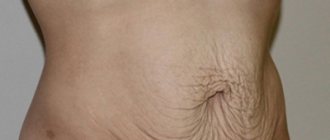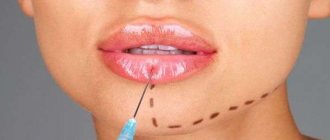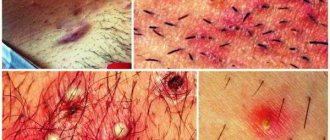Types of scars after cesarean section
There are several types of sutures for this delivery. The choice of one or another incision directly depends on the course of labor.
In emergency situations, when quick access to organs is required (for example, when there is a threat of death of the mother and/or child, transverse position of the fetus, myomatous nodes, etc.), a corporal CS is performed. In this case, a vertical scar remains on the abdomen from the navel to the pubic area.
The most common type of incision for CS remains the Pfannenstiel laparotomy. In this case, the seam is located horizontally, in the area of the natural suprapubic fold, and is therefore practically invisible. The transverse suture, unlike the longitudinal one, is carried out using self-absorbable materials, which also makes the scar after a cesarean section more accurate.
What are the types of scars?
As you know, a caesarean section is performed as prescribed by a doctor if a woman for some reason is unable to give birth on her own. The incision can be made in different ways. If this is a planned operation, then doctors make a laparotomy - an incision across the wall of the uterus and abdominal cavity.
When the operation is completed, ligatures are placed on the uterus, and the abdominal wall is sutured, resulting in a suture being formed in the natural folds of the skin. At first it is too noticeable and looks very unpleasant, but then the scar heals. Ultimately, the scar after surgery becomes almost invisible over time.
But sometimes childbirth can be accompanied by unusual situations or consequences. For example, if the mother experiences severe bleeding or the child experiences hypoxia, the incision is made vertically. Over time, such a suture after a cesarean section becomes thicker and looks unsightly.
Quite often, after such an operation, young mothers’ stomach begins to sag above the incision site. To get rid of this, you need to keep your muscles toned and perform a special set of exercises. You need to start doing this not immediately after giving birth, but after recovery, after about a few months.
How to care for a scar immediately after surgery?
Dressings and daily treatment with antiseptic agents are mandatory components of postoperative care. In a hospital setting, these procedures will be carried out by medical staff, and upon discharge, the doctor will definitely tell you about all the nuances of care at home:
- Physical rest (it is forbidden to carry heavy objects, make sudden movements, or put stress on the peritoneum).
- Wearing a postpartum bandage - it reduces pain, stress on posture, accelerates the restoration of elasticity of the skin and muscle tissue, and prevents seam divergence. As a rule, it is recommended to wear it for several weeks after giving birth.
- Therapeutic exercises, such as Kegel exercises.
- Washing the skin and antiseptic treatment around the seam, for example, with hydrogen peroxide.
- Wearing loose cotton underwear.
Competent postoperative care
Renewal of the skin is a very long process, and does not stop after the edges of the suture have grown together and the crust that covered the wound has fallen off.
The process of scar formation and maturation lasts about 9-13 months, and throughout this period the woman must properly care for the incision area so that the scar is less noticeable in the future.
In the first days, women are prescribed medication to reduce pain. Over time, the condition improves, but discomfort accompanies the woman for several more months.
The first treatment of the surgical field and application of a bandage is carried out by the maternity hospital medical staff. The seam is carefully and carefully treated with hydrogen peroxide, which allows it to be disinfected and reduce the load.
The patient should wear a postoperative bandage for the first few days or simply have her stomach tied up. After seven days, the stitches are removed and the woman in labor goes home.
Until the scar is completely healed, it is recommended to wash the wound area only with warm water and treat it with antibacterial drugs. After taking a shower, the seam should be carefully blotted with a soft towel, then covered with a sterile bandage.
During the recovery period, it is also better for a woman to exclude all physical activity aimed at the abdominal muscles (lifting weights, standing up suddenly, etc.).
When is the best time to start treatment?
It is recommended to begin treatment after complete tissue healing. The rate of scar formation depends on many circumstances: type of incision, body type, age, health status, etc.
On average, after 3-6 months the incision is completely filled with connective tissue and epithelial cells, which allows treatment to begin.
How does a suture on the uterus heal?
Don’t forget that after a cesarean section there are also stitches on the uterus. The incision is naturally closed with self-absorbing threads. The doctor monitors his condition, periodically performing ultrasound scans on the patient. As with the external suture, it is important to ensure that the internal one does not come apart and scars correctly.
There are no specific methods for treating and treating uterine scars. In order for the healing of the internal incision to proceed faster, in the postoperative period doctors may recommend douching with special solutions. And of course, intimate hygiene comes first - in order to prevent microflora disturbance, which in some cases leads to undesirable consequences during the healing of internal sutures. Uncharacteristic vaginal discharge should be a reason to consult a doctor.
A woman who has had a caesarean section is advised to plan her next pregnancy no sooner than 2 years later. This period is considered optimal for stabilizing the uterine scar.
There are no standards for the condition of the internal seam either. Usually the doctor evaluates its thickness and the dynamics of the tissue condition after surgery.
There is an opinion that the first cesarean is the right path to another cesarean in the second pregnancy. But this is not always true. In some cases, after surgery, a woman gives birth for the second time naturally.
The method of delivery largely depends on the condition of the scar zone and the course of pregnancy. But risks for pregnancy still exist: rupture of the “old” suture or the placenta accreting into it.
To reduce the risks during the healing of uterine scars and the next pregnancy, it is important to regularly visit a gynecologist.
- share with your friends!
What consequences can result from the desire to get rid of a scar after a cesarean section?
Most scar removal procedures have side effects.
For example:
- chemical peeling can cause erythema, peeling, swelling, changes in skin color and sensitivity;
- laser resurfacing, cryotherapy: pigmentation, secondary scarring;
- hormonal injections: dizziness, headache, metabolic disorders, etc.;
- surgical intervention: bleeding, thrombophlebitis, infection;
- products for external use: itching, irritation, allergic reactions, swelling, etc.
Reviews
Each woman is individual, and the method of treatment in such cases is also selected individually.
The most important criterion remains time - if a woman begins to properly care for the postoperative area on time, the scar may disappear or become less noticeable.
Please leave a review if you have tried any treatments for scars and if they are effective.
A scar left after surgical childbirth can significantly spoil the appearance of a woman’s abdomen, but you want to be beautiful and attractive at any age, regardless of the number of children. Therefore, one of the pressing issues for women is the problem of eliminating the scar, its camouflage.
How to remove a scar after a caesarean section?
There are many methods for treating postoperative scars, they are conventionally divided into:
- cosmetic procedures;
- plastic surgical interventions;
- medicines and folk remedies for external use.
| Cosmetology procedures | |
| Chemical peeling | The procedure consists of exfoliating the surface layer of skin along with the scar, which has been subjected to a chemical burn with acids (phenolic, trichloroacetic, etc.). The depth of exposure and concentration of active ingredients is controlled by a doctor and depends on the characteristics of the scar. The procedure is painful and requires compliance with the rules of care. During a series of such peels, the skin gradually becomes smooth and elastic. |
| Laser resurfacing | The effect of laser on a scar after a cesarean section promotes the evaporation of fluid from the cells and the destruction of scar tissue. As a result, the production of new collagen fibers is stimulated, young cells gradually replace scar tissue, and the skin texture is smoothed. For a more effective result, several procedures are required. |
| Hormonal injections | The introduction of hormonal drugs helps soften the rough tissue and gradually resolve the scar. This is accomplished due to tissue hypoxia in the injection area, decreased proliferation of fibroblasts and synthesis of glycosaminoglycans. This method is used in case of small scars. |
| Cryotherapy | The affected area is frozen with liquid nitrogen. A chemical cold burn, necrosis and subsequent rejection of scar cells occurs. |
| Plastic | |
| Excision | Only used for excision of large scars. There is surgical intervention and laser excision. In the first case, the procedure is carried out using a scalpel. A cosmetic suture is applied to the excision site. The method is traumatic, has contraindications and risks of side effects for the patient. In the second case, the excision is carried out using a laser beam, the affected tissues are coagulated, so there is no risk of bleeding. Over time, the affected area regenerates and is replaced by new cells. |
| Abdominoplasty | Recommended if there is a rough, highly visible scar from a caesarean section, as well as excess skin that cannot be removed through exercise or diet. The purpose of the procedure is to correct the anterior abdominal wall, which is caused by excess fat deposits and overstretched muscles. Through an incision on the abdominal wall, the surgeon removes excess fat, skin, scars, and tightens the muscles. The operation is completed with a cosmetic suture, installation of drainages and application of bandages. |
| Medicines and folk remedies for external use | |
| Gels, ointments, creams | "Kelofibraze" has anti-scar activity, antithrombotic, anti-inflammatory effect. "Kontraktubeks" - softens and smoothes scars. Reduces fibroblast growth, prevents infection. “Kelocode” stimulates the production of collagen, hyaluronic acid, elagen, which are actively involved in the process of healing and regeneration. Promotes gradual smoothing of the skin. "Kelotan" - consists of natural ingredients. Provides optimal conditions for reducing scars and improving the condition of the skin. Has a softening and mild smoothing effect. |
| Traditional methods | Traditional methods will not completely get rid of the scar, but will help reduce discomfort, pain, skin pigmentation, and speed up healing. Beeswax, rosemary and fennel essential oils help restore the skin faster. Lotions with calendula decoction and lemon juice help to even out the color of the scar skin with the rest of the epidermis. Lotions with infusions of beech, verbena, basil, and clover have a mild analgesic effect. |
The essence of the procedure
The laser that will remove the scar consists of several beams that come at a short distance from each other. Some of them are deliberately directed at the scar itself. In it, they evaporate the columns of scar tissue, and the scar has to bring the edges between the micro-holes closer together. So it shrinks from the inside.
Some of the laser beams hit healthy skin around the scar. They cause a thermal reaction here, as a result of which the cells that are responsible for the formation of new skin elements are activated. They synthesize 3D scaffold structures, and they creep onto the scar, causing it to be replaced by normal covering tissue. This way the scar also shrinks on the outside.
- Find out the current offers
- Sign up for a consultation
Online registration
The procedure is sterile: in the area where the laser beams hit, the temperature becomes high - more than sufficient to destroy microbes. There are no burns: the cooling is turned on while the laser device is operating.
There will be no bleeding during the procedure: all blood vessels that fall within the laser’s area of effect are sealed. And if the beam hits the pigment spots, which also often surround the scar, then they also disappear.
Why is it best to consult a dermatologist first?
Any method of removing and/or reducing scars, be it a cosmetic procedure, surgery or the use of anti-scar creams, has its own indications and contraindications.
The use of a particular procedure must be agreed upon with a doctor; only a specialist will be able to assess the feasibility of its implementation, taking into account the patient’s health condition, the size of the scar, the speed of healing, and other factors. Otherwise, the woman may not receive the expected therapeutic effect or harm her own health.
Physical education as a way to combat scars
Even if after childbirth the scar remains very thin and small, the woman may still be unhappy that the walls of her abdomen are sagging. In this case, it is best to go in for sports.
It is recommended to start with pumping up the press after the permission of the gynecologist. We rarely talk about the gym, since young mothers have practically no time for it, but five minutes a day can be allocated for simple exercises, for example, when the baby is sleeping.
Naturally, your stomach will not immediately become flat as before pregnancy. Exercise may sometimes be painful, but it is good for your health. Physical exercise and a postpartum bandage will help you regain your previous shape and fit over time. But the internal organs will be securely fixed through a strong muscle wall. This will prevent them from drooping in the future, you will also get rid of folds, and the seam itself will not be visible unless you look closely at it.
Postpartum complications affecting the appearance and healing status of the wound
The most common postpartum complications include:
- Weeping (more often occurs due to insufficient wound drainage, excess weight, injury to subcutaneous fat, etc.).
- Dehiscence of the suture and opening of bleeding (more often if the recommendations of the postoperative period are not followed).
- Infection and suppuration (due to failure to maintain sterility during and after surgery).
- Formation of a ligature fistula (appears due to infection of suture material or surgical instruments, insufficient treatment of the suture, etc.).
Rehabilitation
After the operation, it is necessary to strictly follow the instructions of the attending physician. Violation of the rules of the recovery period can provoke the formation of new scars. The patient should protect the suture line with prophylactic agents that prevent the development of scars (in particular, Mepiform or Dermatix) and use the bandage for the time prescribed by the surgeon.
It is necessary to protect the scar from sunlight for as long as possible, since UV rays can cause persistent hyperpigmentation. After 1.5-2 months, for a better result, the patient may be recommended conservative treatment or other methods used to correct scars.
What else can you do?
A woman should carefully monitor the condition of the scar and if alarming symptoms appear (redness, soreness, bleeding, discharge of purulent contents, etc.), immediately seek help from specialists!
The following recommendations will help reduce the cesarean scar and its severity:
- Massage: rubbing, kneading, stroking several months after the CS.
- Limiting sun exposure will help prevent skin hyperpigmentation.
- Applying ice promotes faster contraction of the uterus and relieves pain.
A cesarean scar is an inevitable consequence of the operation. Methods for correcting the appearance of a scar should be selected taking into account the nature of the surgical intervention performed, the characteristics of the scar, the woman’s health status, and always after complete healing of the tissue.
June 26, 2021 by anna
Briefly about the procedure
Duration: from 10 to 30 minutes, excluding pain relief time.
Anesthesia: Emla cream, Acriol.
Frequency: 1 time per month.
Drugs: Not used.
Recommended course: at least 2-3 procedures, depending on how long the scar has existed and its structure.
The effect occurs: after the first procedure, then with an increasing effect.










